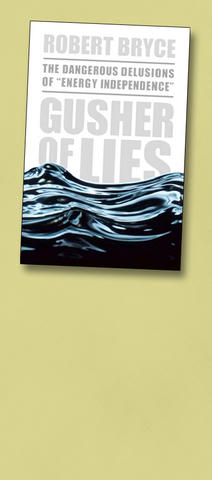After motherhood and apple pie, energy independence probably qualifies as the most popular political slogan in the US. It is, as they say, a no-brainer. Robert Bryce agrees: You have to have no brain to think it is possible or even desirable.
In Gusher of Lies, Bryce, a freelance journalist specializing in energy issues, mounts a savage attack on the concept of energy independence and the most popular technologies currently being promoted to achieve it. Ethanol? A scam. Wind power? Sheer fantasy. Solar power? Think again.
For the foreseeable future, which is to say the next 30 to 50 years, fossil fuels will reign supreme, as they have for the last century. Deal with it.

With all the gusto of a hunter clubbing baby seals, Bruce goes after one cherished green belief after another, but he is an equal-opportunity smiter. Having kicked the props from under every green technology in sight, he goes after the political right.
The current administration and its neo-conservative allies, he argues, have made energy independence part of the war on terror, a moral and tactical blunder. "Energy independence, at its root, means protectionism and isolationism, both of which are in direct opposition to America's long-term interests in the Persian Gulf and globally," he writes.
Bryce begins coolly, then heats up and eventually approaches core meltdown. In a perspective-setting opening chapter, he reviews the history and current state of energy needs in the US, whose situation is not nearly as desperate, he argues, as one might think. Yes, the US depends on foreign oil and natural gas, as it has for many decades, but only 11 percent of its oil came from the Persian Gulf in 2005. It imports 80 percent of its semiconductors and 100 percent of strategic minerals like bauxite and manganese.
Oil, Bruce argues, is simply a commodity. It also costs about the same, in real terms, as it always has. Oil producers need to sell just as badly as customers need to buy. It is undoubtedly true, as US President George W. Bush declared, that "America is addicted to oil." To which Bruce answers, So what?
Besides, he writes, "America's appetite is simply too large and the global market is too sophisticated and too integrated for the US to secede."
After clearing the ground, Bryce gets to work demolishing cherished green beliefs about alternative energy sources. Ethanol, in particular, drives him wild. Fuel derived from corn has channeled billions in subsidies to Midwestern farmers and agribusiness, he writes, despite glaring shortcomings. It is expensive to produce and requires enormous amounts of water when irrigation comes into play. It produces much less energy than gasoline while emitting more pollutants into the air.
Detroit loves ethanol because it can use it to inflate fuel-efficiency ratings on their cars artificially. The mammoth Chevy Suburban, produced as a flex-fuel vehicle capable of burning both ethanol and gasoline, magically boosted its fuel efficiency, since under federal rules only a vehicle's gasoline consumption need be factored into the equation. Ethanol, in other words, has allowed American car manufacturers to produce more gas guzzlers and contribute to increased imports of foreign oil.
The problem with corn and other alternative fuel sources boils down to cost and output. Fuel made from switch grass, another potential solution to the energy problem, costs a lot to produce, delivers a lot less energy than petroleum and would require, like corn, vast areas of farmland to meet a meaningful percentage of current energy needs.
Wind power and solar power have the added drawback of being intermittent and unpredictable. A town that relied entirely on solar or wind power would suffer constant service interruptions and wild fluctuations in output, which is why both technologies must be used in conjunction with traditional fossil-fuel generators.
Bryce lands one telling blow after another, but he favors a slashing, ad-hominem style of attack that can undercut his credibility, especially when he moves away from economics and technology and ventures into politics, an arena to which he brings no particular expertise. He employs a peculiar, almost actuarial assessment of the risk posed by terrorism, which he compares to random events like lightning strikes. This completely misses the point about the threat posed by radical Islam. Using the word "neocon" seems to be enough, for him, to discredit an argument or an opponent.
Fortunately, the book steers back to the high road at the end, when Bryce suggests that there is some light at the end of the tunnel, some of it solar-powered. Within modest limits, he argues, solar power can play a bigger role in meeting energy needs, especially with new technology that transforms infrared light into electricity. Algae look promising as a source of biodiesel.
The major environmental groups may even, eventually, see the point of nuclear power, "the only sector that has enough momentum and enough capital behind it to make a significant dent in the overall use of fossil fuels."
Bryce's pet idea, though, is something that does not exist - a superbattery capable of storing large quantities of electricity. As the magic wand to bring this "silver bullet" into existence Bryce proposes a Superbattery Prize awarded either by the Energy Department or private foundations: US$1 billion, say, for a compact, affordable system that can store multiple kilowatt-hours, and US$10 billion for a system that can store megawatt-hours. The hard-nosed Bryce reveals himself in the end as something of a visionary and perhaps even a revolutionary.

As I finally slid into the warm embrace of the hot, clifftop pool, it was a serene moment of reflection. The sound of the river reflected off the cave walls, the white of our camping lights reflected off the dark, shimmering surface of the water, and I reflected on how fortunate I was to be here. After all, the beautiful walk through narrow canyons that had brought us here had been inaccessible for five years — and will be again soon. The day had started at the Huisun Forest Area (惠蓀林場), at the end of Nantou County Route 80, north and east

Specialty sandwiches loaded with the contents of an entire charcuterie board, overflowing with sauces, creams and all manner of creative add-ons, is perhaps one of the biggest global food trends of this year. From London to New York, lines form down the block for mortadella, burrata, pistachio and more stuffed between slices of fresh sourdough, rye or focaccia. To try the trend in Taipei, Munchies Mafia is for sure the spot — could this be the best sandwich in town? Carlos from Spain and Sergio from Mexico opened this spot just seven months ago. The two met working in the

Exceptions to the rule are sometimes revealing. For a brief few years, there was an emerging ideological split between the Democratic Progressive Party (DPP) and Chinese Nationalist Party (KMT) that appeared to be pushing the DPP in a direction that would be considered more liberal, and the KMT more conservative. In the previous column, “The KMT-DPP’s bureaucrat-led developmental state” (Dec. 11, page 12), we examined how Taiwan’s democratic system developed, and how both the two main parties largely accepted a similar consensus on how Taiwan should be run domestically and did not split along the left-right lines more familiar in

A six-episode, behind-the-scenes Disney+ docuseries about Taylor Swift’s Eras Tour and Rian Johnson’s third Knives Out movie, Wake Up Dead Man, are some of the new television, films, music and games headed to a device near you. Also among the streaming offerings worth your time this week: Chip and Joanna Gaines take on a big job revamping a small home in the mountains of Colorado, video gamers can skateboard through hell in Sam Eng’s Skate Story and Rob Reiner gets the band back together for Spinal Tap II: The End Continues. MOVIES ■ Rian Johnson’s third Knives Out movie, Wake Up Dead Man